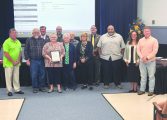By Heather Michon
Correspondent
Board of Supervisors met for its regular meeting at the Fluvanna County Library on Wednesday (Sept. 1) for a relatively brief session that focused heavily on the American Rescue Plan Act (ARPA) and how it might be used by the county.
Fork Union Sanitary District
The Morris and Omohundro wells in the Fork Union Sanitary District (FUSD) require state-mandated repairs and rehabilitation at a cost of $290,250. The only question before the supervisors was how to pay for it.
Water and sanitation repairs and improvements fall under the American Rescue Plan Act (ARPA) and could be drawn from the current $2.6 million allocated to the county. Supervisors could also pull funds from FUSD’s $164,000 fund balance.
Supervisors decided to leave the fund balance untouched and pull the full amount from ARPA on a 5-0 vote.
American Rescue Plan Act
Fluvanna County has been allocated $5,296,878 under American Rescue Plan Act. The first tranche of $2.6 million arrived on June 10, and the final $2.6 million should appear in June 2022.
They have until Dec. 31, 2024 to use the funds or return unspent portions to the Treasury Department.
But spending it is going to be complicated.
Under ARPA, the county can use the funds for public health, addressing the negative economic impacts of COVID-19, replacing lost revenue, paying premium wages to essential workers, and improving water, sewer, and broadband access.
Purchasing officer Cyndi Toler ran through a detailed list of all the things ARPA could cover, but cautioned that there were a lot of things the supervisors may want that don’t qualify.
One example that came up in the discussion was a new ambulance. Chair Mike Sheridan (Columbia) and Supervisor Tony O’Brien (Rivanna) theorized that an additional ambulance might qualify due to the increased burden on fire & rescue.
This would also take some of the burden off the county budget by allowing them to buy a big-ticket item outright, rather than funding them through loans.
However, Toler said they would have to prove that the purchase was due entirely to COVID-19, and auditors would almost certainly deny that type of purchase.
But there are many ways they can use the funds, from grants and loans to wastewater upgrades, to supplemental pay for frontline workers.
Supervisor Mozell Booker (Fork Union) strongly urged that the county hire someone who could coordinate and monitor ARPA and COVID-19 related issues.
Future meeting space
Since losing their longtime meeting space at the county courthouse in the first days of the COVID-19 lockdown, the Board has struggled to find a new home.
They met for some time in the Morris Room at the county administration building, came close to being able to build a new meeting space in the basement of the building under a previous federal funding act but ran out of time, and have been meeting for the last several months in the library’s community room, which the library would like to start to use for other purposes.
With few spaces available in the county, they have settled on the Performing Arts Center at Carysbrook, starting with their Sept. 15 meeting.
County Administrator Eric Dahl said the need for space and distancing has been in his mind, as he has recently tested positive for COVID-19.
He joined the meeting remotely
“Being someone that was fully vaccinated, I don’t want to say that I thought I was not likely to get it — but I’m surprised I have it, that’s for sure,” he said.
Other matters
Supervisors also unanimously approved:
- A resolution in support of a Transportation Alternative Program (TAP) grant for VDOT’s Palmyra Village Streetscapes Project;
- A supplemental funding request for $472,000 in debt funding for fire & rescue to cover increased costs in new vehicles and apparatus.
Fluvanna County Library received an achievement award from the Virginia Association of Counties (VACO) for its efforts to serve the community during the pandemic. Jeremy Bennet, VACO’s director of intergovernmental affairs, praised the library’s innovative use of programs like virtual story time, curbside delivery, and grab-n-go activity kits.




